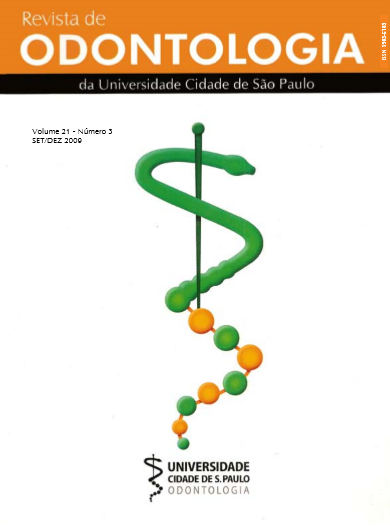Febre na infância: conhecimento, percepção e atitude materna
DOI:
https://doi.org/10.26843/ro_unicid.v21i3.463Palavras-chave:
Febre, Criança, Conhecimento, Percepção, Atitude.Resumo
Introdução: O objetivo deste trabalho é determinar o conhecimento, a percepção e a atitude de mães diante da febre de suas crianças, atendidas na Disciplina de Odontopediatria da Faculdade de Odontologia de Ribeirão Preto-USP. Métodos: Sessenta mulheres, com faixa etária entre 17 e 45 anos foram selecionadas. Um questionário foi aplicado, incluindo-se perguntas sobre as causas, consequências e cuidados domiciliares com a febre. Informações adicionais sobre o uso de medicamentos para tratamento da febre e efeitos colaterais decorrentes também foram obtidas. Os dados foram agrupados e submetidos à análise percentual. Resultados: Para detectar a presença de febre, 58 (96,7%) mães tocavam a pele da criança em locais como testa (58,3%) e pescoço (31,7%) e 46 (76,7%) das mães utilizavam o termômetro. Todas as mães relataram que febre alta pode provocar problemas graves de saúde, como convulsão (90%), delírio (66,7%) e perda de peso (55%). Antipirético era sempre oferecido às crianças com febre, mas antibióticos não eram administrados (96,7%). 71,6% das mães acreditavam que antibióticos provocam efeitos colaterais, principalmente alergia (46,7%) e alterações nos dentes (86,7%), como a cárie dentária (63,3%). Conclusão: Assim, apesar da crescente ênfase em educação em saúde, informações básicas sobre febre são necessárias para reduzir o medo e ansiedade das mães.Downloads
Referências
Adam D, Stankov G. Treatment of fever in childhood. Eur J Pediatr 1994 Jun; 153(6): 394-402.
Adam HM. Fever and host responses. Pediatr Rev 1996 Sep; 17(9): 330-1.
Al-Eissa YA, Al-Sanie AM, Al-Alola SA, Al-Shaalan MA, Ghazal SS, Al-Harbi AH et al. Parental perceptions of fever in children. Ann Saudi Med 2000 May- Jul; 20(3-4): 202-5.
Al-Nouri L, Basheer K. Mother? s perceptions of fever in children. J Trop Pediatr 2006 Apr; 52(2): 113-6.
Aronoff DM, Neilson EG. Antipyretics: mechanisms of action and clinical use in fever suppression. Am J Med 2001 Sep; 111(4): 304-15.
Baraff LJ, Bass JW, Fleisher GR, Klein JO, McCracken GH Jr, Powell KR et al. Practice guideline for the management of infants and children 0 to 36 months of age with fever without source. Agency for Health Care Policy and Research. Ann Emerg Med 1993 Jul; 22(7): 1198-210.
Blumenthal I. What parents think of fever. Fam Pract 1998 Dec; 15(6): 513-8
Bradley MB, Kinirons MJ. Choice of sugar-free medicines by a sample of dentists, doctors and pharmacists in Northern Ireland: the views of parents and health professionals. Community Dent Health 1998 Jun; 15(2): 105-8.
Casey R, McMahon F, McCormick MC, Pasquariello Jr PS, Zavod W, King Jr FH. Fever Therapy: An Educational Intervention for Parents. Pediatrics 1984 May; 73(5): 600-5
Connell F. The causes and treatment of fever: a literature review. Nurs Stand 1997 Dec; 3-9;12(11):40-3.
Crocetti M, Moghbeli N, Serwint J. Fever phobia revisited: have parental misconceptions about fever changed in 20 years? Pediatrics 2001 Jun; 107(6): 1241-1246.
Dinarello CA, Wolff SM. Pathogenesis of fever in man. N Engl J Med 1978 Mar; 298(11): 607-12.
Goldman RD, Scolnik D. Underdosing of acetaminophen by parents and emergency department utilization. Pediatr Emerg Care 2004 Feb; 20(2): 89-93.
ImpicciatoreP,NanniniS,PandolfiniC,BonatiM. Mothers? knowledge of, attitudes toward, and management of fever in preschool children in italy. Preventive Medicine 1998 Mar-Apr; 27(2): 268? 73.
Kai J. What worries parents when their preschool children are acutely ill, and why: a qualitative study. BMJ 1996 Oct; 19; 313(7063): 983-6.
Kinmonth AL, Fulton Y, Campbell MJ. Management of feverish children at home. BMJ 1992 Nov; 305(6862): 1134-6.
Kluger MJ. Is fever really a ? side-effect? ? of biologicalresponse modifiers? Lancet 1992 Feb: 22; 339(8791):491.
Kramer MS, Naimark L, Leduc DG. Parental fever phobia and its correlates. Pediatrics 1985 Jun; 75(6): 1110-3.
Linder N, Sirota L, Snapir A, Eisen I, Davidovitch N, Kaplan G et al. Parental knowledge of the treatment of fever in children. Isr Med Assoc J. 1999 Nov;1(3):158-60.
Macknin ML, Piedmonte M, Jacobs J, Skibinski C. Symptoms associated with infant teething: a prospective study. Pediatrics 2000 Apr; 105(4Pt1); 747- 52.
. May A, Bauchner H. Fever phobia: the pediatrician? s contribution. Pediatrics 1992 Dec; 90(6): 851-4.
McErleanMA,BartfieldJM,KennedyDA,Gilman EA, Stram RL, Raccio-Robak N. Home antipyretic use in children brought to the emergency department. Pediatr Emerg Care 2001 Aug; 17(4): 249-51.
Roth J, Zeisberger E, Vybíral S, Janský L. Endogenous antipyretics: neuropeptides and glucocorticoids. Front Biosci 2004 Jan: 1; 9: 916-26.
Sarrell M, Cohen HA, Kahan E. Physicians? , nurses? , and parents? attitudes to and knowledge about fever in early childhood. Patient Educ Couns 2002 Jan; 46(1): 61-5.
Schmitt BD. Fever phobia: misconceptions of parents about fevers. Am J Dis Child 1980 Feb; 134(2): 176-81.
Singhi S, Padmini P, Sood V. Urban parents? understanding of fever in children: its dangers, and treatment practices. Indian Pediatr 1991 May; 28(5): 501-5.
Silva VS, Silva AN, Maia LC. Antibacterianos pediátricos e cárie dental em crianças: mitos e realidades. Rev Paul Pediatr 2002 Ago; 20(4): 191-5.
Teng C, Ng CJ, Nik-Sherina H, Zailinawati AH, Tong SF. The accuracy of mother? s touch to detect fever in children: a systematic review. J Trop Pediatr 2008 Fev; 54(1):70-3. Epub 2007 Nov. 25.

